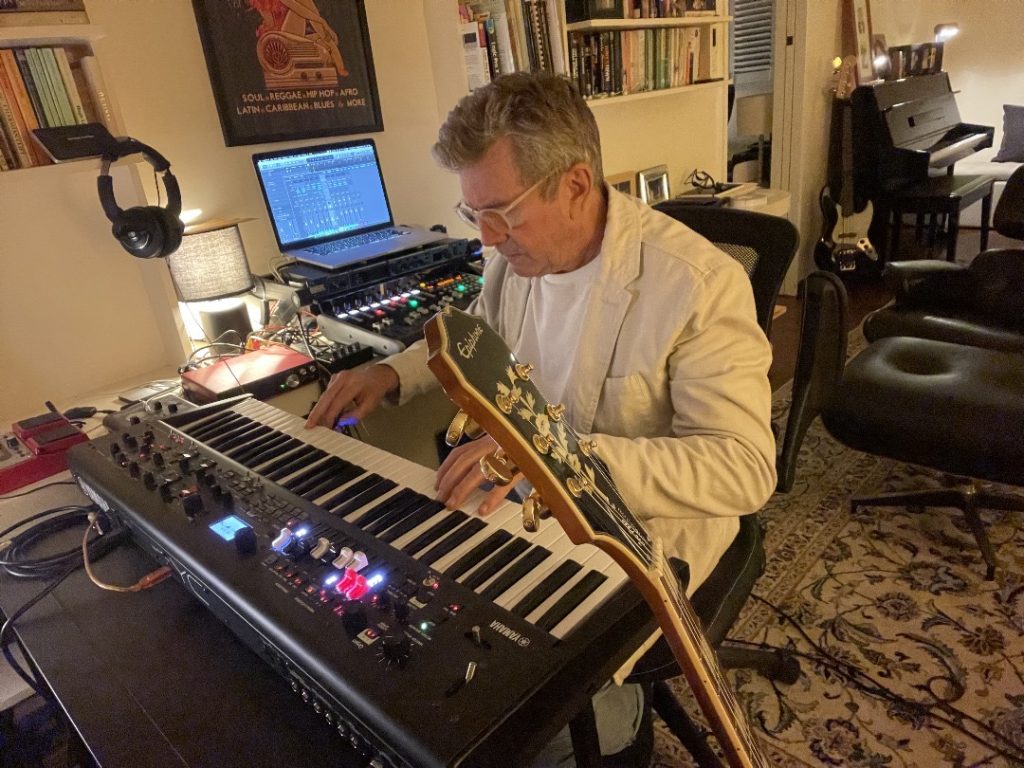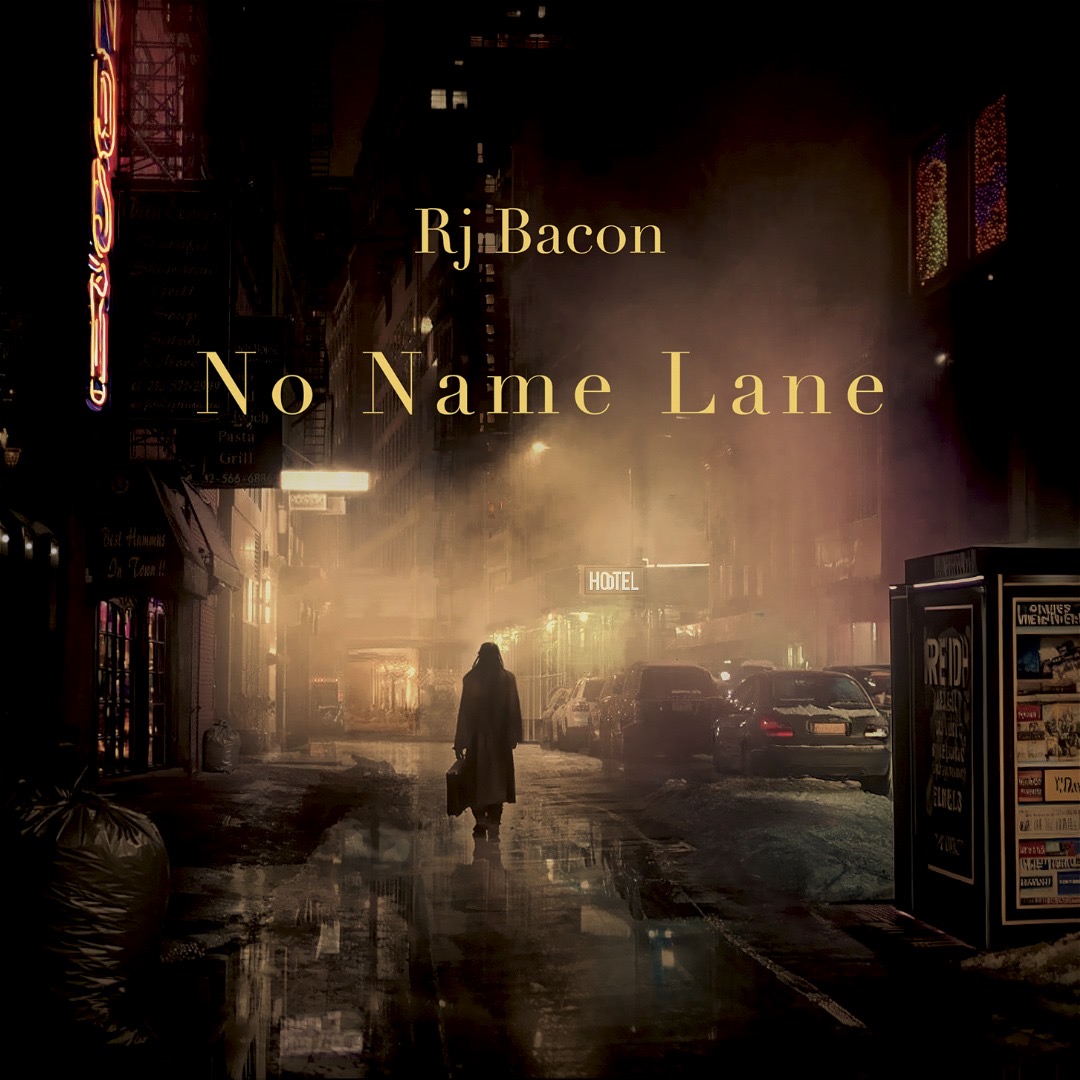Credit: R Bacon
Rj Bacon, a Sydney-based artist, has had a long and diverse career that began in the camera department at ABC Television in 1979. His career has taken him through various genres in television—news, documentaries, and more notably, high-end television dramas and films. With a deep history in cinematography, Rj (also known as Russell Bacon) has worked on iconic Australian shows like ‘Brides of Christ’, ‘Police Rescue’, and ‘Packed to the Rafters’, as well as international hits like the cult sci-fi series ‘Farscape for the US SyFy network. Over the years, he has transitioned from behind the camera to behind the music, crafting a unique style of smooth jazz in his own Sydney studio.
Bacon’s expertise in cinematography has given him a unique perspective on atmosphere, lighting, and mood—elements that clearly influence his music. These days, he works alone in his studio, writing, recording, and producing smooth, bluesy jazz tracks, playing all instruments himself, resulting in a seamless fusion of artistry where disagreements are resolved within. His foray into music has yielded a series of successful albums that echo a timeless, cool vibe, rooted in jazz and blues.

Rj Bacon’s latest release, “No Name Lane”, represents the eighth chapter in his growing catalogue of lounge jazz albums, following previous works like ‘Three Minute Noodles’, ‘Roslyn Street’, and ‘Beyond the Perpendicular’, Released on August 23rd, 2024, this album continues Bacon’s mastery of atmospheric, laid-back jazz, while introducing new elements of blues fusion. Recorded entirely in Bacon’s Sydney studio, “No Name Lane” captures a specific retro jazz club vibe, as if the listener has been transported to a dimly lit room with soft chatter and the clinking of glasses in the background. The album embodies what some have dubbed “dry martini music,” perfect for setting a mood of relaxation or introspection. The seamless flow between each track exemplifies Bacon’s ability to evoke a certain mood without overpowering the listener with complex arrangements or vocal performances. His use of instrumental tracks only amplifies this effect, allowing the music to take center stage as a meditative backdrop to any environment.
The album consists of seven original tracks that flow effortlessly, each steeped in smooth, blues-infused jazz rhythms. From start to finish, the music creates a soothing atmosphere that builds subtly but never breaks its tranquil tone. Unlike many jazz albums that venture into more chaotic, improvisational territories, “No Name Lane” remains consistent, providing a relaxing journey through mellow, bluesy tunes. Bacon’s multi-instrumental prowess is on full display here, with each layer of the music contributing to a rich, cohesive soundscape that feels both intimate and expansive.
No Name Lane Album Track List:
Johnny Beanstalk:
The first song on ‘No Name Lane’, called “Johnny Beanstalk,” establishes the mood for the whole album with its classic jazz vibes. The rich, atmospheric soundscape from the very beginning captivates the listener, embodying the essence of jazz with its captivating and soothing, vibrant and relaxed qualities. Without any singing, the attention is solely on the musical skill, letting the music itself be the main focus. This song demonstrates Rj Bacon’s profound knowledge of jazz as both a form of art and an emotional experience.
“Johnny Beanstalk” demonstrates the various layers of sound that contribute to jazz’s versatility. Every instrument is provided with the opportunity to stand out, from the fundamental rhythm of the bass to the sleek, melodic tunes of the saxophone and piano. The combination of these elements blends effortlessly, establishing a lively interaction among them, with no instrument dominating the others. Rather than that, the various sounds blend together to create a unified, engaging sensation that takes the listener to a peaceful, nightclub-like setting.
The calming atmosphere of the track serves as the perfect introduction to the album, offering a preview of what’s in store while still retaining its unique essence. “Johnny Beanstalk” sets the tone for the album by showcasing bluesy elements that are further explored, and also serves as an exceptional example of instrumental jazz. The music invites listeners to relax, shut their eyes, and allow the music to envelop them, as if they were in a dimly lit jazz club, wholly engrossed by the performance.
Freeway:
“Freeway,” the third track on ‘No Name Lane,’ is a mesmerizing instrumental that blends calmness with a feeling of seamless movement. Staying true to its title, the song brings to mind the sensation of driving along a vast highway, as its soft rhythms and heartfelt tunes create a peaceful mood from the beginning. Lacking any vocals, “Freeway” solely relies on its instrumental arrangement to establish a calming mood for the listener.
The track’s power comes from its gradual unfolding of sounds, layered subtly as the composition moves forward. It starts with a gentle rhythm, which is then enhanced by a heartfelt, calming tune that connects the various instruments. New elements are added as the music progresses, creating a richer sound without losing the laid-back feel. The interaction among these levels is skillfully designed, creating the sensation of a musical voyage that evolves continuously while maintaining its unity.
Even with its increasing intricacy, “Freeway” stays a consistent and harmonious experience throughout. Every instrument contributes a unique texture to the composition, but no one dominates over the others, creating a smooth and harmonious mix. The song highlights Rj Bacon’s skill in creating complex jazz pieces that are both impressive in technique and incredibly soothing. It demonstrates how a skillfully crafted instrumental piece can engage the listener and offer a deep, captivating experience.

The Toff:
The fifth track on ‘No Name Lane‘, titled “The Toff,” dives straight into a jazz-infused rhythm from the moment it begins, capturing the listener’s attention with its immediate energy. The track doesn’t waste time building up; instead, it immerses you right into a world of mellow yet rhythmically sharp jazz. The instruments take center stage, each contributing to a sound that is as smooth as it is vibrant, with the jazz elements shining prominently throughout the composition.
At its core, “The Toff” balances relaxation with an undeniable rhythmic drive. While the music is mellow, it carries an underlying sharpness that gives the track its unique edge. The jazz instruments, from the gentle piano melodies to the warm, flowing saxophone, exude a sense of calm, yet there’s a noticeable pulse that keeps the track moving. This blend of mellow tones with rhythmic intensity creates a captivating contrast, making the track both soothing and engaging at the same time.
The sharp yet tinged quality of the music adds depth to the track, offering moments where the melody cuts through with precision, keeping the listener hooked. Despite its laid-back nature, “The Toff” has a richness in its composition that gives it a textured feel, ensuring it stands out as a highlight on the album. It encapsulates the essence of jazz—relaxing yet full of life—and invites listeners to enjoy a mellow, rhythmic journey that’s as captivating as it is soothing.
No Name Lane:
The closing and titular track of “No Name Lane” serves as a fitting conclusion to the album, wrapping up the journey with a soothing and rhythmic jazz piece. As the final statement on the record, “No Name Lane” encapsulates the essence of the album’s laid-back, bluesy atmosphere. The track’s light, rhythmic vibe exudes a sense of calm, while the well-tinged melodies offer a delicate balance between relaxation and engagement. It perfectly mirrors the ambiance of a quiet night in a jazz club, where the music flows effortlessly and creates a serene backdrop.
The rhythmic pulse of the track is subtle yet captivating, allowing the instruments to intertwine smoothly while maintaining a cohesive and relaxed flow. “No Name Lane” builds on the themes established in the previous tracks but takes on a more reflective tone, offering a sense of closure. The arrangement is carefully crafted, with each instrument contributing to the overall richness of the composition without overwhelming the listener. It’s a track that invites you to sit back and let the music wash over you, immersing you in its light and breezy rhythm.
As the last track on the album, “No Name Lane” feels like the perfect ending to a night of smooth jazz. Its mellow, rhythmic quality leaves a lasting impression, lingering in the air like the final notes played in a dimly lit club. The track, much like the album as a whole, embodies the soul of jazz—rich, rhythmic, and relaxing—giving listeners one final moment of musical tranquility before the journey comes to a close.
While the album sticks closely to its core identity of lounge jazz, it has moments where blues fusion breaks through, creating a dynamic yet restrained contrast to the rest of the tracks. This fusion brings a certain emotional depth, balancing the light, airy moments with a touch of smokiness. Every note feels deliberate, and the precision in the production speaks to Bacon’s years of experience in the world of visual and audio storytelling.
In “No Name Lane”, Rj Bacon continues to build on his established sound, perfect for those looking to unwind, sip a cocktail, or reminisce about old jazz clubs with low lights and good company. It’s music that doesn’t demand attention but rather invites you to get lost in its grooves. Whether you’re a seasoned jazz enthusiast or new to the genre, this album offers a gateway into the soul of jazz with a laid-back yet emotionally resonant touch. With no vocals and nothing but smooth, instrumental excellence, “No Name Lane” is a meditative experience that you’ll want to revisit again and again, especially on quiet evenings when all you need is some cool, soulful jazz to guide you down that nameless lane.
For more information about Rj Bacon, click on the icons below.

